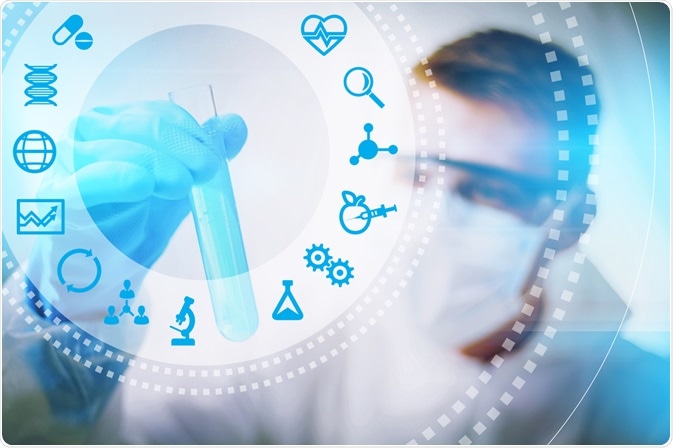For over ten thousand years, people have been involved in harnessing different biological processes to improve their quality of life. The use of microorganisms to make bread, alcoholic beverages, and the making of cheese are some of the common examples of the application of biotechnology.
In 1960, the term “biotechnology” first came into light with the emergence of genetics, molecular, and cellular technologies. Biotechnology is a science that utilizes biological processes for the development of different fields of science and technology such as agriculture, medicine, environment, industry, etc.
After 1976, several pharmaceutical companies, such as Amgen, Genentech, Cetus, Biogen, and Genex were established, which manufacture genetically engineered products, primarily for environmental and medical purposes.

Biotechnology. Image Credit: Mikko Lemola/Shutterstock.com
Basics of Biotechnology
As stated above, biotechnology is based on genetic engineering which includes recombinant DNA technology. In this technology, the targeted gene, that encodes a specific protein, is spliced and incorporated into a cell (yeast, bacteria, mammalian cell culture, etc.) which produces the targeted protein in high volume. The process of insertion of specific genes into an organism results in the creation of a new organism.
In 1982, recombinant insulin became the first product to receive approval from the Food and Drug Administration (FDA). Subsequently, numerous genetically engineered proteins and enzymes have secured commercial approval across the world to be used in the treatment of various diseases. Some of the approved recombinant products include growth hormones, proteins for stimulating the production of red and white blood cells, development of monoclonal antibodies, clotting factors, clot-dissolving agents, and interferons. Biotechnology research has also spread its wings in agriculture by producing genetically modified organisms (GMO).
In 1994, FDA approved the first genetically engineered tomato which had a longer shelf life. In recent years, scientists have developed various genetically modified crops, for example, crops that are resistant to pathogenic infestations or herbicides (chemicals used for killing weeds), and have received approval from regulatory bodies in the United States and Europe. Researchers have also secured FDA approval for bovine somatotropin (BST) which is a growth hormone that enhances the production of milk in dairy cows.
Types of Biotechnology
Biotechnology is applied to bring about advancements in various fields of science and technology. Some of the main types of biotechnology are discussed below:
Medical Biotechnology
Medical biotechnology uses living cells and cellular materials for the treatment of various diseases. It is used to develop pharmaceutical drugs to combat diseases. Medical Biotechnology is involved with the development of vaccines that stimulates the body’s immune system to fight against pathogens that cause harmful diseases. Medical biotechnologists have created various antibiotics for humans.
Agricultural Biotechnology
As the name suggests, this type of biotechnology deals with agricultural development. It focuses on the creation of genetically engineered plants by incorporating the genes of those plants that are genetically superior, in terms of, yields, biotic and abiotic stress tolerance, growth, metabolite production, etc.
In this technology, scientists primarily identify a specific gene bearing desirable traits, and splice that gene and incorporate it into another plant, thereby, developing the genetically modified plant. For example, scientists have incorporated genes of Bacillus thuringiensis, which produce a protein (Bt) that is extremely effective against pests (e.g., European corn borer), to crops (e.g., corn) to develop a new pest-resistant variety.
Industrial Biotechnology
Biotechnology is applied in different kinds of industries such as chemical manufacturing, detergents, paper, textiles, etc. Industrial biotechnology uses microorganisms or products of cellular components, e.g., enzymes (biocatalyst), which is essential for various industrial sectors such as food, animal feed, biofuels, and biogas.
It not only helps to improve the quality of products but also reduces the harmful industrial byproducts. Further, it is also used for the lowering of the emission of greenhouse gases.
Environmental Biotechnology
This technology is actively used to prevent pollution and waste treatments. In comparison to conventional treatments, environmental biotechnology has proved to be a more efficient and cost-effective approach. This technology uses various microorganisms, especially bacteria, that can ingest the waste products and degrade them.
Hence, these bacteria can digest the waste at the site of disposal and convert them into harmless byproducts. One of the important aspects of environmental biotechnology is bioremediation, which helps in the reduction of heavy metal pollution.
An alternative definition of biotechnology is based on colors. These are discussed below:
- Red Biotechnology: This color represents the development of biopharmaceutical products which includes medicinal veterinary products.
- White Biotechnology: This color represents industrial biotechnology.
- Yellow Biotechnology: This color of biotechnology is related to the technology of food production, e.g., in making cheese, wine, and beer by fermentation.
- Grey Biotechnology: This color represents the environmental applications of biotechnology. It helps maintain biodiversity and lower pollutants using plants and microorganisms.
- Green Biotechnology: This color of biotechnology deals with agriculture, which includes the development of new plant varieties, biopesticides, and biofertilizers.
- Blue Biotechnology: This color of biotechnology is involved with using marine resources.
- Violet Biotechnology: This color deals with the ethical, law, and philosophical aspects of biotechnology.
- Dark Biotechnology: This color represents biowarfare. It is associated with bioterrorism or biological weapons that cause diseases and deaths in humans, domestic animals, and crops, using microorganisms, and toxins.
Conclusion
As stated above, since the middle of the 1970s, biotech industries have started to grow with the early establishment of companies such as Cetus (now part of Novartis Diagnostics) and Genentech. Since then, various innovative biotech companies have started to form in the United States, especially in Seattle, North Carolina's Research Triangle Park, Boston, and Philadelphia.
Additionally, rapid growth also took place in Berlin and Munich (Germany), Oxford and Cambridge (United Kingdom), Denmark, and Sweden. According to a 2020 report, the global biotechnology market was valued at USD 752.88 billion and the analysts further expect the value to expand at a compound annual growth rate (CAGR) of 15.83% from 2021 to 2028.
Biotechnology is the future of manufacturing | Chris Pudney | TEDxBeechenCliffSchool
Further Reading
Last Updated: Oct 31, 2022